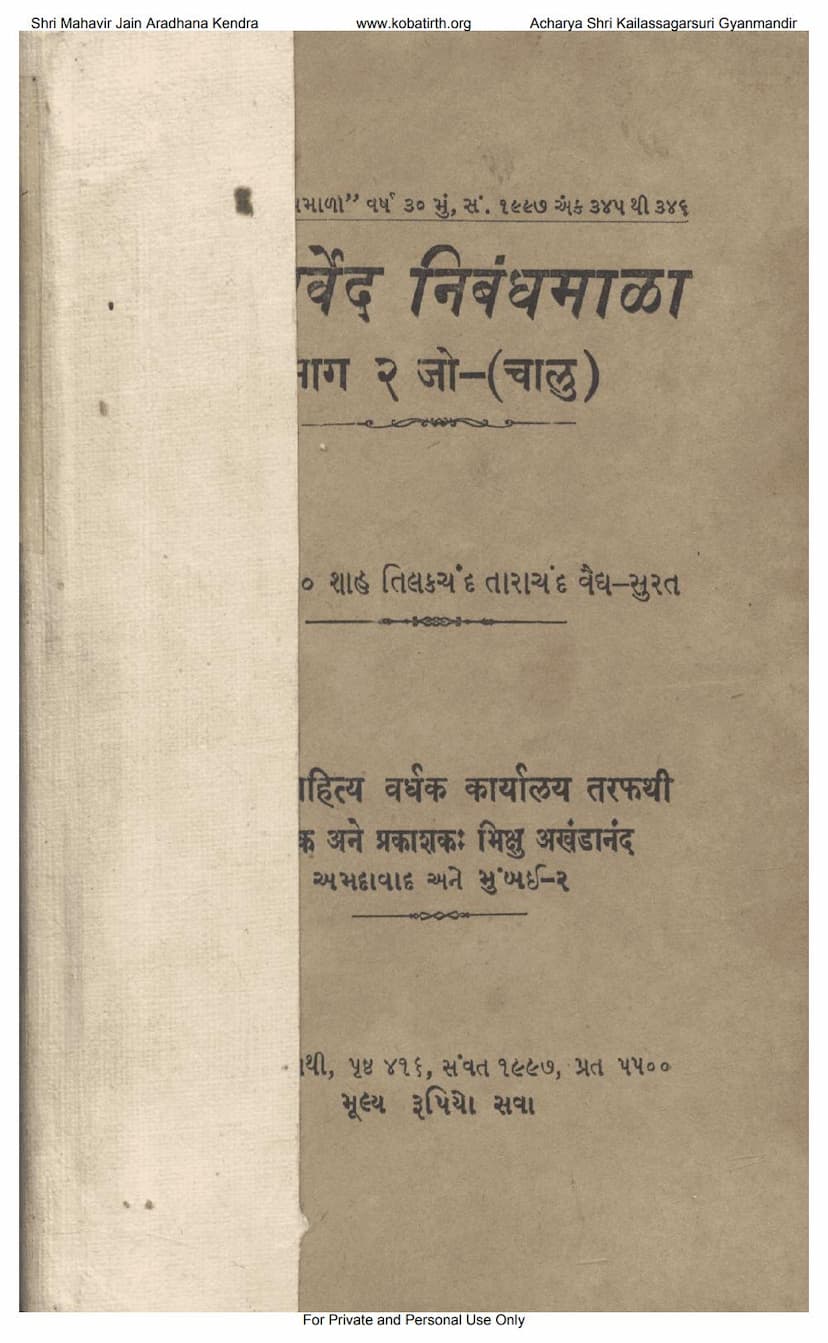Aayurved Nibandhmala Part 02
Added to library: September 1, 2025

Summary
This is a comprehensive summary of the Jain text "Aayurved Nibandhmala Part 02" by Tilakchand Tarachand Vaidya, published by Sastu Sahityavardhak Karyalay, based on the provided pages:
Book Title: Aayurved Nibandhmala Part 02 (आयुर्वेद निबंन्धमाला भाग २ जो) Author: Tilakchand Tarachand Vaidya (शाह तिलकचंद ताराचंद वैघ) Publisher: Sastu Sahityavardhak Karyalay (सस्तु साहित्य वर्धक कार्यालय) Language: Gujarati
Overview:
The text "Aayurved Nibandhmala Part 02" is the second part of a larger work on Ayurveda, compiled and published by Sastu Sahityavardhak Karyalay. It is a detailed exploration of various Ayurvedic principles, treatments, and remedies, presented in a structured manner with numerous chapters and specific recommendations. The book aims to provide practical knowledge of Ayurveda for the benefit of readers.
Key Themes and Content:
- Foundation of Ayurveda: The text begins by emphasizing the importance of a physician's knowledge, wisdom, diagnostic skills, and inherent nature (बुद्धि, निदान, धाम) in successful treatment, stating that true healing comes from the combination of these qualities, rather than solely from the physician's actions. It also touches upon the philosophical aspect that suffering and happiness are ultimately dictated by karma, but a capable physician can alleviate the causes of illness.
2s. Structure and Compilation: The book is presented as part of a larger series, with this volume containing the remaining essays and appendices not included in "Aayurved Nibandhmala Part 1". The publisher notes that the original work was extensive, leading to its division into volumes for better accessibility.
-
Scope of Diseases and Treatments: The book offers comprehensive information on a wide array of diseases and their treatments according to Ayurvedic principles. The table of contents and the text itself reveal coverage of conditions such as:
- Digestive and Abdominal Issues: Shool Rog (colic/pain), Gulm Rog (abdominal tumors/masses), Udavart Rog (abdominal distention/bloating), Udarg Rog (abdominal diseases), Ajirna (indigestion), Atisaar (diarrhea), Sangrahani (malabsorption).
- Urinary and Reproductive System Issues: Mutrakrichchha (urinary difficulty), Mutraghat (urinary obstruction), Ashmari (calculi/stones), Prameh Rog (urinary disorders including diabetes).
- Enlargements and Swellings: Andvruddhi (hydrocele/scrotal swelling), Galgand (goiter), Gandmal (scrofula/lymphadenopathy), Granthi (glandular swellings), Abund (abscess/tumor).
- Skin and Allergic Conditions: Sheetpit (urticaria), Visarp (erysipelas), Visphotak (boils/eruptions).
- Genitourinary and Sexual Health: Shukradosh (semen disorders), Upadansh (syphilis/venereal diseases).
- Eye, Ear, Nose, and Throat Ailments: Netrarog (eye diseases), Karnrog (ear diseases), Nasarg (nasal diseases), Mukharog (mouth diseases).
- Specific Remedies and Formulations: The text details numerous medicinal preparations including various Vati (pills), Churna (powders), Ras (medicated juices/liquids), Aasav/Arishta (fermented preparations), Bhasma (calcined substances), Sindoor, Lep (ointments/pastes), and Tel (oils).
- Specific Herbs and Minerals: Mention is made of numerous medicinal ingredients like Hing, Gandhak, Suvarna Makshik Bhasma, Abhrak Bhasma, Ras Sindoor, Shilajit, various minerals (like copper, iron, silver, gold), and a vast array of herbal remedies.
- Diagnostic and Therapeutic Principles: The text implicitly discusses diagnosis by describing symptoms and explicitly provides treatments, often including specific dosages, preparation methods, and dietary recommendations.
-
Author's Experience and Approach: The author, Tilakchand Tarachand Vaidya, emphasizes that the remedies and treatments provided are based on his personal experience, ancient Ayurvedic texts, and his own discoveries. The text highlights a practical approach, offering simple methods for preparation and administration of medicines.
-
Subscription and Publication Details: The publisher, Sastu Sahityavardhak Karyalay, provides information about the publication, including its circulation within the "Vividh Granthmala" (विविध ग्रंथमाला) series, subscription details, and pricing. They also mention the author's passing and acknowledge his contribution.
-
Jain Context: The "JAIN EDUCATION INTERNATIONAL FOR PRIVATE AND PERSONAL USE ONLY" and the Shri Mahavir Jain Aradhana Kendra/Kobatirth.org affiliations suggest a connection to Jain scholarship and educational institutions, indicating that the preservation and dissemination of such traditional knowledge are valued within this community.
Summary of Chapters/Sections (based on the index):
The extensive index provided covers a wide spectrum of diseases and treatments, including but not limited to:
- Pain and Digestive Issues: Shool Rog, Gulm Rog, Udavart Rog (with detailed descriptions of causes, symptoms, and specific remedies like Gandhak Vati, Gandhak Vati, Samir Gagesari Ras, etc.).
- Urinary and Metabolic Disorders: Prameh Rog (diabetes and related conditions), Mutrakrichchha, Mutraghat, Ashmari (kidney stones) with numerous remedies and formulations.
- General Diseases: Udarg Rog (abdominal diseases), Shoth Rog (edema/swelling), Andvruddhi (hydrocele/scrotal swellings), Galgand, Gandmal, Granthi, Abund, Bhagandar (fistula), Sheetpit (urticaria), Visarp, Visphotak.
- Sexual Health and Rejuvenation: Shukradosh, Upadansh, Vajikaran (aphrodisiacs).
- Specific Conditions: Netrarog (eye diseases), Mukharog (mouth diseases), Karnrog (ear diseases), Nasarg (nasal diseases), Mastakrog (head/brain diseases).
- Metals, Minerals, and Alchemy: Sections on the purification (Shodhan) and incineration (Marana) of various metals and minerals like Tamra (copper), Bhasma (ash), Loh Bhasma, Abrak Bhasma, Parada Bhasma, Suvarna Bhasma, etc., and their use in medicinal preparations.
- Ras Vidya (Alchemy/Metallurgy): A significant portion of the book is dedicated to the science of Rasashastra, detailing processes for preparing various Sindoor, Bhasma, and other complex preparations, highlighting the intricate knowledge of metal and mineral processing in Ayurveda.
- Pediatric Care: Numerous remedies and treatments for diseases affecting children, including fevers, coughs, digestive issues, and convulsions.
- Gynecological Issues: Treatments for various conditions affecting women, such as Amenorrhea (nashtartav), Lehi (excessive bleeding/pradar), Shwetpradar (leukorrhea), and issues related to pregnancy and childbirth.
- General Health and Well-being: Discussions on maintaining health, diet, lifestyle, and specific remedies for common ailments.
Overall Significance:
"Aayurved Nibandhmala Part 02" stands as a valuable resource for anyone interested in traditional Indian medicine, particularly Ayurveda. It showcases the depth and breadth of Ayurvedic knowledge, covering a wide range of diseases with practical, often empirically tested, remedies. The text reflects a commitment to preserving and disseminating this ancient wisdom for the well-being of society. The inclusion of specific recipes, preparation methods, and the author's emphasis on personal experience make it a practical guide for practitioners and interested individuals alike.